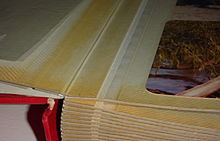Archiving adhesive photo albums
| This is a research project at Wikiversity. |
| Type classification: this is an article resource. |
This article explains how to archive photographic prints that have been stored in 'adhesive' photograph albums by removing them from the old albums, digitizing them, and moving them into long-term archivial enclosures.
Reading list[edit | edit source]
- Preserve Your Treasures: How To Remove Photos from a Sticky Album, by the Smithsonian Archives.
- Tricks and Tools for Removing Family Photos from Sticky, Deteriorating Magnetic Photo Albums, by Cora Foley, 2016-11-18.
Explanation of 'magnetic' or adhesive albums[edit | edit source]

There are many different types of photograph album; we deal here with one common in the last three or four decades of the twentieth century and up to the present day. These have thick board or paper pages which are coated with a weak adhesive, and plastic covers for each page that fully enclose and stick to the mounted photos. The problem with these albums, from a long-term archival point of view, is that the chemical interactions between the materials of the album and those of the photograph can damage the image. For this reason, it is best to remove the photographs into more stable storage systems (and ones from which they will be more easily removed, should the new materials turn out to have similar problems).
The photographs can adhere to the page and in some cases to the plastic wrap making their removal difficult, and the longer that photographs are stored in these albums the more firmly they can stick. Below, we describe a method for removing stuck photographs that does not cause excessive damage to the image.
Preparation[edit | edit source]
Before doing anything more, document the existing arrangement. Take photos of the albums and write descriptions of them in as much detail as you can, in order to preserve as much provenance information as possible. These photos and descriptions will form part of the final (digital) catalogue for the photos.
Removal of photographs[edit | edit source]
The first step in removing photographs from these albums is to peel back the plastic page-covering sheet. This is usually less adhesive than the page itself, but care should be taken. Apply force at a low angle as the sheet is being removed, as the image surface is more likely to be stronger in this way than when drawn upwards from the page.

Once the photograph is exposed, a assesement can be made about how firmly fixed it is to the adhesive page. If the album is not too old, it is likely that the photograph will be quite easy to remove simply by sliding a thin palette knife or microspatula underneath it.
If the adhesive is too strong, and an attempt to get anything under an edge is liable to damage the photograph, the knife can be dipped in methylated spirits, in order to dissolve the advesive to some extent. Methylated spirits has the advantage that it evaporates completely, leaving no residue.
Digitization[edit | edit source]
Scan the photos at at least 400 dpi and save them in PNG format. Regularly clean the glass of the scanner, as well as the white backing on the lid (because residue of adhesive can build up on this and be transferred between items being scanned). For more information about the (immense) topic of digitizing still images, see Commons:Help:Scanning and the other resources referenced on that page.
Cataloguing and metadata[edit | edit source]
As photos are being removed from an album it is important to record any captions and other metadata that might be written on the page from which they're being taken. Also record the order/position that each photo had in the album (a numeric index is fine, starting from 1 at the beginning of each album).